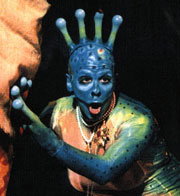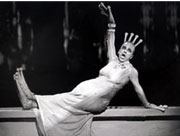|
|
|
[INDEX]
 Abandon
all preconceptions about baroque opera, ye who enter here. The New York
City Opera's production of Platée, Jean-Philippe Rameau's 250 year old
ballet bouffon about a lonely lady frog delusionally in love with the
god Jupiter, is a riotous cabaret that may do more to popularize musique
ancienne in New York than respectable musicology and the authentic instrument
movement have been able to do over the last 40 years. Abandon
all preconceptions about baroque opera, ye who enter here. The New York
City Opera's production of Platée, Jean-Philippe Rameau's 250 year old
ballet bouffon about a lonely lady frog delusionally in love with the
god Jupiter, is a riotous cabaret that may do more to popularize musique
ancienne in New York than respectable musicology and the authentic instrument
movement have been able to do over the last 40 years.
Saucily directed by choreographer Mark Morris, with outrageous costumes
by fashionista Isaac Mizrahi, this is a mythological camp-o-rama that
simultaneously updates, exaggerates, and illuminates an unjustly neglected
baroque masterpiece.
Platée's prologue is set in a seedy modern bar patronized by a colorful
group of 20th century caricatures, including a black sailor, a masculine
lesbian, a gaudy showgirl, a veiled baroness, and a bribe-taking cop.
Thespis, Inventor of Comedy, gets drunk and hatches the opera's "practical
joke" plot. The gods decide to punish the tiresomely jealous Juno by hooking
up Jupiter with the lovelorn Platée. Platée is the ugly frog who tries
to seduce anybody (or anything) that walks, hops or slithers into view.
To celebrate their scheme, Thespis, Bacchus, Thalie, Momus and the bar's
other patrons break into dance.
Dance is always an important part of French baroque opera. When Rameau
wrote this entertainment in 1745, he parodied the hackneyed conventions
of antique theater. For us, Morris parodies the dance conventions of Rameau's
day. Instead of methodical Renaissance mincing, Morris's dancers perform
stylized parodies of the Can Can, the Charleston, classical ballet, square
dancing, and Fred-and-Ginger waltzing. The choreography is an anachronistic
outrage, but Rameau's musty gavottes, courantes, and allemaines never
looked or sounded fresher.
With the breath-taking entrance of Platée herself (played by French tenor
Jean-Paul Fauchécourt - photo above - in amphibious drag), this production
moves from parody to riveting tragicomedy. When the dazzling God of Gods
Jove descends on a cloud, poor Platée is fooled into believing she has
found true love at last.
 Since
French tenor Jean-Paul Fauchécourt debuted the title role in this production
three years ago, his remarkable interpretation has grown into an inimitable
incarnation. Rameau wrote the part for a haute contre, a high voice close
to what the English call a countertenor, or male alto. Platée is basically
a comic drag role sung by a man, like the old maid Arnalta in Monteverdi's
Poppea. But thanks to Fauchécourt, Platée emerges not just as a flippant,
flippered joke, but as a vulnerable and sensitive soul who, like David
Merrick's Elephant Man, is trapped in a misshapen body which dooms her
to loneliness. Since
French tenor Jean-Paul Fauchécourt debuted the title role in this production
three years ago, his remarkable interpretation has grown into an inimitable
incarnation. Rameau wrote the part for a haute contre, a high voice close
to what the English call a countertenor, or male alto. Platée is basically
a comic drag role sung by a man, like the old maid Arnalta in Monteverdi's
Poppea. But thanks to Fauchécourt, Platée emerges not just as a flippant,
flippered joke, but as a vulnerable and sensitive soul who, like David
Merrick's Elephant Man, is trapped in a misshapen body which dooms her
to loneliness.
Along the way, one applauds Fauchécourt's grotesque airs and graces, pretensions
and flirtations, as he fondles his pearls with webbed hands, gazes through
a lorgnette, and waggles his pendulous bottom. No one who has seen this
show would deny Platée her place in the pantheon of immortal amphibians,
alongside Kermit the Frog.
The Mark Morris Dance Group superbly mimed (without the aid of special
costumes) a menagerie of dancing animal extras including a snake, cockatiel,
alligator, peacock, toad, blue jay, duck, robin, and newt. The show was
also quite raunchy. Morris has said in the past that "staging Baroque
opera as if you had a stick up your butt" is of no interest to him. Indeed,
the show was full of partial nudity, including Momus in a bum-revealing
jockstrap and three Satyrs spanking themselves into a frenzy.
The principal singers were all good, with special kudos for crystalline
soprano Amy Burton's portrayal of L'Amour and La Folie; tenor Matthew
Chellis's Mercure; Christine Brandes's Lizard in Waiting, and Bernard
Deletré's Jupiter. Conductor Daniel Beckwith made a lively, memorable
New York City Opera debut.
Platée is only the latest in a series of stunning Broadway-style treatments
of Baroque repertoire that have changed the way we think about our musical
heritage. Europe has been getting this dramatic tonic for decades, but
only recently has it reached American shores. Let's hope Mark Morris's
Platée signals the beginning of a permanent revolution.
> New York City Opera
[INDEX]

|
|
|


